

Prolific Labs LLC. Students struggling with how to use quotes?
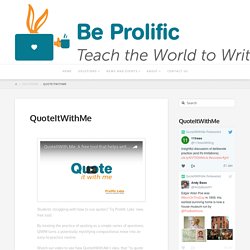
Try Prolific Labs’ new, free tool! By treating the practice of quoting as a simple series of questions, QIWM turns a potentially mystifying compositional move into an easy-to-practice routine. Watch our video to see how QuoteItWith.Me’s idea, that “to quote is to question,” helps writers stop plagiarizing their sources, and start analyzing them instead.
Assignment Suggestion Have students visit QuoteItWith.Me and frame a dozen quotations from different sources. Through simple practice—guided by QIWM—students perform, repeat, and learn the steps necessary to correctly introduce and attribute quotations.quotations. QuoteItWith.me starts with a friendly request to paste in a quote. This means answering the simple questions that build a citation: who said it, where, when? The Educator’s Guide to Copyright, Fair Use, and Creative Commons. The Edublogs support team regularly receives complaints and official requests to remove copyrighted content that users have placed on blogs.

The legal jargon with respect to digital copyrights can be confusing – especially since different countries have their own laws and regulations. Understanding digital copyright is an essential skill we need to understand and teach our students. With this post, we hope to dispel a few myths and pull together a complete list of resources for teachers and students to use when blogging and working with content online. This post was originally written by Ronnie Burt, on the Edublogger, on Feb, 2012. It’s been re-written with content and comments from the original post combined with updated content by Sue Waters. 8 infographics about public domain and copyright. This collection of infographics will let you learn about the current state of copyright law.
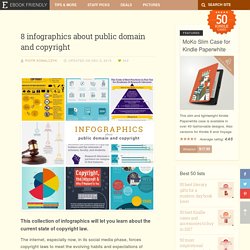
The internet, especially now, in its social media phase, forces copyright laws to meet the evolving habits and expectations of internet users. What’s the best solution that could satisfy both sides: the copyright holder, and the user? The extremes are out of the equation. One extreme is the copyright law in an understanding from 100 years ago. The other is unlimited access and sharing of the somebody else’s intellectual property. Everyone should be given the freedom to learn. The goal is clear, but the rules are unclear. What’s more, there are now several rules, not only the “all-rights-reserved”. What do the four fair use factors mean? – Help Center. A Fair(y) Use Tale. So… You Want (Have) To Create Something? Image licensed under Creative Commons by Nancy Sims – No doubt, the issue of copyright in the age of CREATING is of utmost importance.

Where can you get the images, audio and video you need in order to create and remix for projects, homework and your own interests and passions? Step1: Become aware and understand different copyright licenses. Step 2: What is Creative Commons? (from CreativeCommons.org ) The idea of universal access to research, education, and culture is made possible by the Internet, but our legal and social systems don’t always allow that idea to be realized. Step 3: Know where to find images, audio and video that are re-use/remix friendly Sites to search Public Domain & Creative Commons images Sites for Creative Commons audio.
How to Identify Mysterious Images Online. Can’t figure out the source of an image you found online?

There’s an easy trick you might not know about — and it’s an essential tool for citing sources. Taking the Mystery Out of Copyright. Skip navigation Library of Congress Teachers Suggestions enabled.
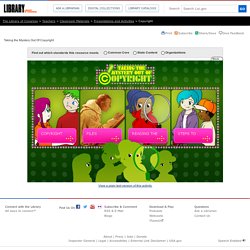
The Library of Congress > Teachers > Classroom Materials > Presentations and Activities > Copyright Print Subscribe Share/Save Give Feedback. Kirby Ferguson: Embrace the remix. Creative Commons licences explained. Where's The Fair Use? - Nostalgia Critic. Copyright kids. Youtube Copyright Center. Columbia University Libraries. A Visual Guide To Creative Commons Licensing. A Visual Guide To Creative Commons Licensing Creative Commons licensing was one of the best things that ever happened to the internet.
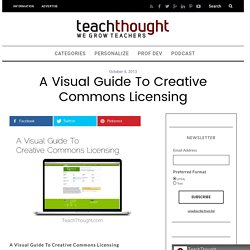
Where once the internet was an untamed beast overran by plagiarism, non-attributed image theft, copyright confusion, and super shaky sense of who owns what–well, really that hasn’t changed for most. But for those paying attention, Creative Commons licensing offers an oasis of both simple rules and a communal framework that allows both media publishers and media consumers the ability to be on the same page. This is especially important in education, where teachers and students take to the internet daily to find, curate, publish and share every form of digital media. Often teachers end up in 1 of 2 camps: 1. 2. With this context in mind, the following graphic from foter.com does an excellent job of putting all of the need-to-know information in one very visual package that’s easily shared and saved.
Copyright Law and Ethics. Copyright and legal issues The Arts Law Centre of Australia and the Australian Copyright Council provides up-to-date resources that cover many of the issues faced by filmmakers.
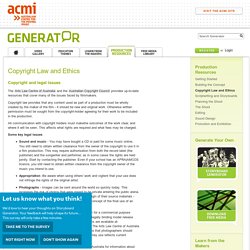
Copyright law provides that any content used as part of a production must be wholly created by the maker of the film - it should be new and original work. Plagiarism.org. Interactive Graphic about Copyright. Today we are adding this wonderful resource from Cyberbee.
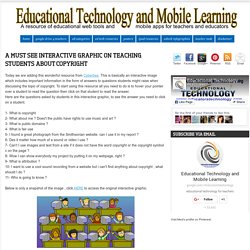
This is basically an interactive image which includes important information in the form of answers to questions students might raise when discussing the topic of copyright. Copyright and Fair Use Guidelines. Frequently Asked Questions about Copyright and Fair Use. What is fair use?
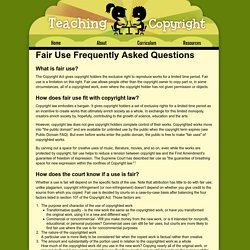
The Copyright Act gives copyright holders the exclusive right to reproduce works for a limited time period. Fair use is a limitation on this right. Fair use allows people other than the copyright owner to copy part or, in some circumstances, all of a copyrighted work, even where the copyright holder has not given permission or objects. How does fair use fit with copyright law?
Copyright law embodies a bargain. However, copyright law does not give copyright holders complete control of their works. By carving out a space for creative uses of music, literature, movies, and so on, even while the works are protected by copyright, fair use helps to reduce a tension between copyright law and the First Amendment's guarantee of freedom of expression. How does the court know if a use is fair? Britannica - Study Guide. As you begin to work on more research papers and evidence-based projects, you will find that providing citations for all of the research you use will be a required part of your work to help you ensure academic honesty. We’ve put together a collection of activities to help you gain some valuable citation skills. In our Activity Centre you will find activities and information about how to identify plagiarism so you can prevent it, how to paraphrase information and how to accurately cite research. Our activities are based on the Britannica article “Climate” and use the information within the article to show you how to use your research and information.
You’ll also find some fun activities like a crossword puzzle, word search and quiz. Copyright resources for teachers. August 12, 2014 Now that the new school year is about to start, it would be great to devote a session with your students where you can talk to them about issues related to copyright and proper use of digital artifacts from the net. This will definitely help them make better and informed decisions as to the kind of materials they are allowed to use in their work and provide them with practice on the different ways they can appropriately credit sources.
This resourceful page embeds a wide variety of materials to use in this regard, browse through the items featured there and bookmark the ones you plan to use with your students. I am also sharing with you this wonderful graphic that debunks 5 myths about copyright infringement. Creative Commons.